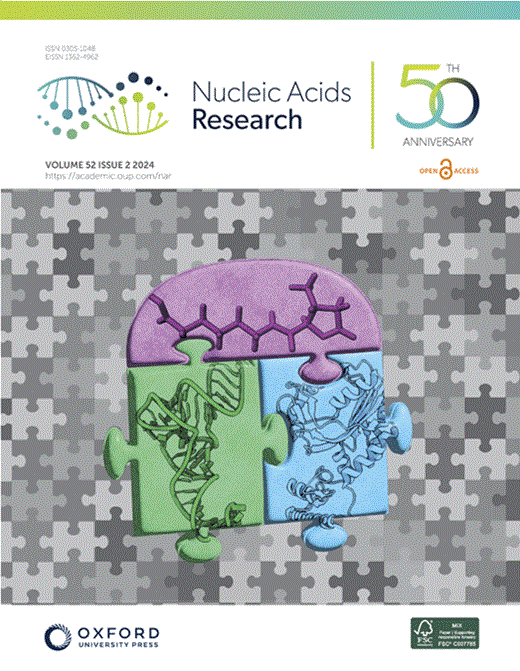CRISPR RNA结合驱动结构排序,启动Cas7-11进行目标切割
IF 16.6
2区 生物学
Q1 BIOCHEMISTRY & MOLECULAR BIOLOGY
引用次数: 0
摘要
III-E型CRISPR-Cas效应物,被称为Cas7-11或巨型重复相关神秘蛋白,是一种切割靶RNA (tgRNAs)而不进行非特异性侧切的单蛋白,为RNA编辑开辟了新的可能性。在这里,生化分析结合酰胺氢-氘交换质谱(HDX-MS)实验揭示了载脂蛋白Cas7-11的动力学。HDX-MS结果提示了一种机制,通过CRISPR RNA (crRNA)稳定蛋白质的折叠状态,随后与tgRNA结合将其重塑为活性形式。HDX-MS显示,4个Cas7 RNA识别基序(RRM)折叠良好,但插入序列,包括Cas7.2/Cas7.3活性位点的无序催化环和β-发夹,在结合crRNA时折叠,导致域-域界面上更强的相互作用,并折叠Cas7.1加工位点。TgRNA结合引起Cas7.2和Cas7.3催化环周围的构象变化。我们发现Cas7-11不能独立加工CRISPR阵列,部分加工的crRNA的结合在Cas7-11中诱导多种状态并减少tgRNA的切割。插入结构域与成熟crRNA的相互作用最为稳定。最后,我们在一个与Cas/ hef1相关信号传感器(TPR-CHAT)结合位点融合的四肽重复序列中发现了crRNA诱导的构象变化,从而解释了crRNA结合促进TPR-CHAT结合的原因。本文章由计算机程序翻译,如有差异,请以英文原文为准。
CRISPR RNA binding drives structural ordering that primes Cas7-11 for target cleavage
Type III-E CRISPR–Cas effectors, referred to as Cas7-11 or giant Repeat-Associated Mysterious Protein, are single proteins that cleave target RNAs (tgRNAs) without nonspecific collateral cleavage, opening new possibilities for RNA editing. Here, biochemical assays combined with amide hydrogen–deuterium exchange mass spectrometry (HDX–MS) experiments reveal the dynamics of apo Cas7-11. The HDX–MS results suggest a mechanism by which CRISPR RNA (crRNA) stabilizes the folded state of the protein and subsequent tgRNA binding remodels it to the active form. HDX–MS shows that the four Cas7 RNA recognition motif (RRM) folds are well-folded, but insertion sequences, including disordered catalytic loops and β-hairpins of the Cas7.2/Cas7.3 active sites, fold upon binding crRNA leading to stronger interactions at domain–domain interfaces, and folding of the Cas7.1 processing site. TgRNA binding causes conformational changes around the catalytic loops of Cas7.2 and Cas7.3. We show that Cas7-11 cannot independently process the CRISPR array and that binding of partially processed crRNA induces multiple states in Cas7-11 and reduces tgRNA cleavage. The insertion domain interacts most stably with mature crRNA. Finally, we show a crRNA-induced conformational change in one of the tetratricopeptide repeat fused with Cas/HEF1-associated signal transducer (TPR-CHAT) binding sites providing an explanation for why crRNA binding facilitates TPR-CHAT binding.
求助全文
通过发布文献求助,成功后即可免费获取论文全文。
去求助
来源期刊

Nucleic Acids Research
生物-生化与分子生物学
CiteScore
27.10
自引率
4.70%
发文量
1057
审稿时长
2 months
期刊介绍:
Nucleic Acids Research (NAR) is a scientific journal that publishes research on various aspects of nucleic acids and proteins involved in nucleic acid metabolism and interactions. It covers areas such as chemistry and synthetic biology, computational biology, gene regulation, chromatin and epigenetics, genome integrity, repair and replication, genomics, molecular biology, nucleic acid enzymes, RNA, and structural biology. The journal also includes a Survey and Summary section for brief reviews. Additionally, each year, the first issue is dedicated to biological databases, and an issue in July focuses on web-based software resources for the biological community. Nucleic Acids Research is indexed by several services including Abstracts on Hygiene and Communicable Diseases, Animal Breeding Abstracts, Agricultural Engineering Abstracts, Agbiotech News and Information, BIOSIS Previews, CAB Abstracts, and EMBASE.
 求助内容:
求助内容: 应助结果提醒方式:
应助结果提醒方式:


